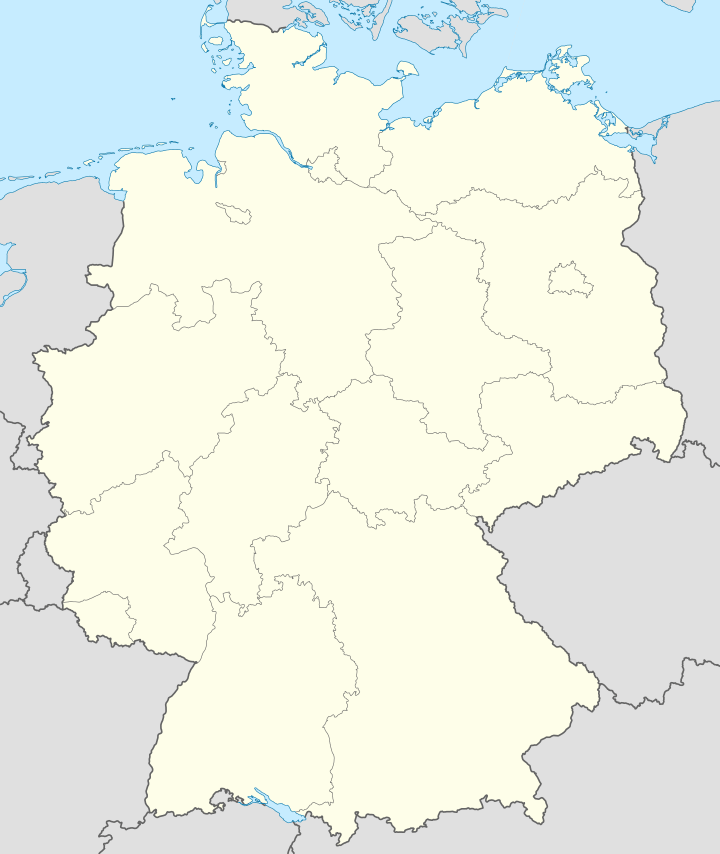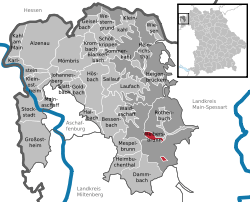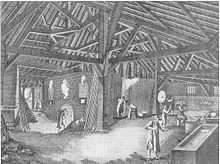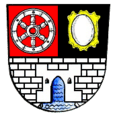Weibersbrunn
| Weibersbrunn | ||
|---|---|---|
| ||
 Weibersbrunn | ||
Location of Weibersbrunn within Aschaffenburg district  | ||
| Coordinates: 49°56′N 9°22′E / 49.933°N 9.367°ECoordinates: 49°56′N 9°22′E / 49.933°N 9.367°E | ||
| Country | Germany | |
| State | Bavaria | |
| Admin. region | Unterfranken | |
| District | Aschaffenburg | |
| Government | ||
| • Mayor | Walter Schreck (Weibersbrunner Liste e.V.) | |
| Area | ||
| • Total | 2.89 km2 (1.12 sq mi) | |
| Population (2013-12-31)[1] | ||
| • Total | 1,951 | |
| • Density | 680/km2 (1,700/sq mi) | |
| Time zone | CET/CEST (UTC+1/+2) | |
| Postal codes | 63879 | |
| Dialling codes | 06094 | |
| Vehicle registration | AB | |
| Website | www.weibersbrunn.de | |
Weibersbrunn is a community in the Aschaffenburg district in the Regierungsbezirk of Lower Franconia (Unterfranken) in Bavaria, Germany.
Geography
Location
The community lies in the Bavarian Lower Main (Bayerischer Untermain).
The community has the following Gemarkungen (traditional rural cadastral areas): Weibersbrunn, Rohrbrunner Forst.
History
Weibersbrunn was founded in 1706 as a location for a new centre of the Electoral Mainz mirror manufacturer, which already maintained glassworks in Lohr and Rechtenbach. In 1717 the Weibersbrunner Spiegelhütte (“Weibersbrunn Mirror Plant”) came into being. In 1746, the plant’s workers applied to their employer to build their own parish church or at least a chapel.
The Baroque glass cups and goblets being made in Weibersbrunn brought the community widespread fame, and the semicircular crown glass sheets – called Mondglas or “Moon Glass” – that were also made here led to international fame for the community.
The Electoral Mainz area in the High Spessart was merged into the Principality of Aschaffenburg in 1803 and in 1810 it became part of the Grand Duchy of Frankfurt, shortly thereafter, however, passing between 1814 and 1816 to the Kingdom of Bavaria by way of Austria. In the course of administrative reform in Bavaria, the current community came into being with the Gemeindeedikt (“Municipal Edict”) of 1818.
In 2006, the community marked its 300th anniversary with a great festival.
Rohrbrunn
The once autonomous community of Rohrbrunn achieved a greater measure of fame from the so-called former "Spessart Inn" (Wirtshaus im Spessart), whose name was used as the title of a narrative by Wilhelm Hauff, and also of the 1958 film based on the book. Also here is the Jagdschloss Luitpoldhöhe which, built in 1889, was Prince Regent Luitpold’s hunting lodge. He resided here on hunting trips between 1886 and 1911.
Population development
Within community limits in 1970, 1,817 inhabitants were counted, in 1987 1,934, in 2000 2,146 and in 2006 2,109.
The figures given for Weibersbrunn’s population in the 19th century are 721 in 1826, 960 in 1852 and 817 in 1859 (Klauprecht 1826, Virchow 1968, Hecht/Reder 2002).
Politics
Community council
The Weibersbrunn council is made up of 15 council members, counting the full-time mayor.
| CSU | SPD | Total | |
| 2002 | 7 | 8 | 15 seats |
| 2008 | 6 | 9 | 15 seats |
(as at municipal election held on 2 March 2008)
Mayors
The mayor is Herbert Rüppel (SPD). In 2002 he succeeded Erich Noll (SPD).
Coat of arms
The community’s arms might be described thus: Per fess, in chief per pale gules and sable, dexter a wheel spoked of six argent, sinister a mirror of the third framed Or, in base a spring walled of the third and masoned of the second with an open gate through which flows water azure.
The arms show above the fesswise (that is, horizontal) partition a six-spoked silver wheel – the Wheel of Mainz – on the dexter (armsbearer’s right, viewer’s left) side. This was the heraldic charge borne by the Archbishopric of Mainz, to which the community belonged until the Old Empire’s downfall in 1803. It is also shown in Electoral Mainz’s tinctures. On the sinister (armsbearer’s left, viewer’s right) side is a mirror symbolizing the glassworks established in the community in 1698 and in Rechtenbach and Lohr am Main. Archbishop Lothar Franz von Schönborn hired French glassmakers for this enterprise. Their plants made plate glass for mirrors. Glassmaking was ended between 1801 and 1803 in Rechtenbach and Lohr am Main, but only in 1864 in Weibersbrunn. The spring is a canting charge referring to the last syllable in the community’s name – “spring” is Brunnen in German.
The community has borne the arms since 14 June 1971.
Economy and infrastructure
Municipal tax revenue amounted in 1999 to €975,000 (converted), of which net business taxes accounted for €144,000.

According to official statistics, there were 52 workers on the social welfare contribution rolls working in producing businesses in 1998. In trade and transport this was 41. In other areas, 304 workers on the social welfare contribution rolls were employed, and 818 such workers worked from home. Nobody was employed in processing businesses. Two businesses were in construction, and furthermore, in 1999, there were as many agricultural operations.
Education
In 1999 the following institutions existed in Weibersbrunn:
- Kindergartens: 100 places with 72 children
- Primary school with 9 teachers and 166 pupils
Famous people
Sons and daughters of the town
- Ignaz Roth (1894–1972), German politician (SPD)
References
- ↑ "Fortschreibung des Bevölkerungsstandes". Bayerisches Landesamt für Statistik und Datenverarbeitung (in German). 31 December 2013.
Further reading
- Julia Hecht, Klaus Reder: Die Landgerichte Aschaffenburg und Rothenbuch um 1860. Würzburg 2002.
- Johann Ludwig Klauprecht: Forstliche Statistik des Spessarts. Aschaffenburg 1826.
- Rudolf Virchow (1852): Die Not im Spessart. Neuauflage, Hildesheim 1968.
External links
-

Wikimedia Commons has media related to Weibersbrunn.
